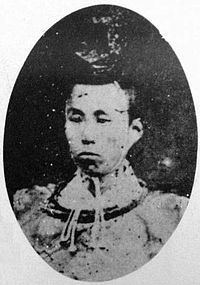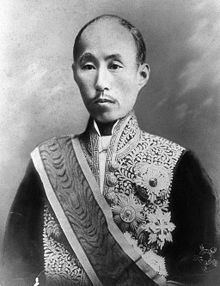Monarch Meiji Name Sanjo Sanetomi | Role Statesman | |
 | ||
Children Chieko Kotohitoshinnohi, Kinteru Sanjo Grandchildren Princess Tsuneyoshi Mitsuko, Princess Hiroko Great grandchildren Tsunekazu Takeda, Prince Takeda Tsunetada | ||
Prince Sanjō Sanetomi (三条 実美, 13 March 1837 – 18 February 1891) was an Imperial court noble and statesman at the time of the Meiji Restoration. He held many high-ranking offices in the Meiji government.
Contents
Biography

Born in Kyoto, Sanjō was the son of Naidaijin Sanjō Sanetsumu. He held several important posts in Court and became a central figure in the anti-Western, anti-Tokugawa sonnō jōi ("Revere the Emperor, Expel the Barbarian") movement.
When the coup d’etat of September 30, 1863 brought the more moderate Aizu and Satsuma factions into power, he fled to Chōshū. He returned to Kyoto after the resignation of Shogun Tokugawa Yoshinobu in 1867.
The first administrative offices (Sanshoku) of the Meiji government were established on January 3, 1868: the Sōsai (President), Gijō (Administration) and San'yo (Office of Councilors). These offices were abolished on June 11, 1868, with the establishment of the Daijō-kan (Grand Council of State). In the new Meiji government, Sanjō was head of the Gijo, Minister of the Right (右大臣) (June 11, 1868 – August 15, 1871), and Chancellor of the Realm (Daijō-daijin) (August 15, 1871 – December 22, 1885).
Sanjō was awarded Grand Cordon of the Supreme Order of the Chrysanthemum in 1882. On July 7, 1884, his title was changed to that of koshaku (prince) under the kazoku peerage system.
Sanjō served until the abolition of the daijōkan system in 1885. After the Cabinet system was established, he became Lord Keeper of the Privy Seal of Japan.
In 1889, when Prime Minister Kuroda Kiyotaka and his cabinet resigned en masse, Emperor Meiji only accepted Kuroda’s resignation and formally invited Sanjō to head the government. The Emperor refused to appoint a new prime minister for the next two months, making Sanjō the only Prime Minister of Japan (albeit interim) who also concurrently held the post of Lord Keeper of the Privy Seal.
In 1890, he assumed a seat in the new House of Peers in the Diet of Japan established by the Meiji Constitution. On his death in 1891, he was accorded a state funeral. His grave is at the temple of Gokoku-ji in Bunkyō, Tokyo.
Honours
From the corresponding article in the Japanese Wikipedia
